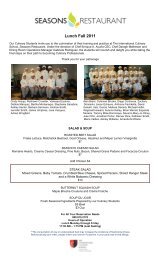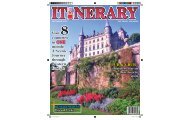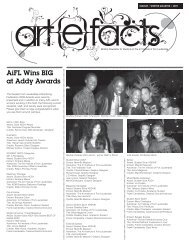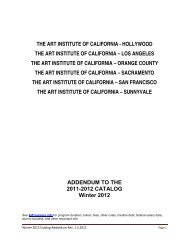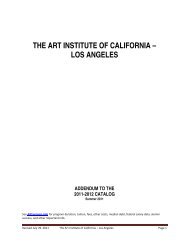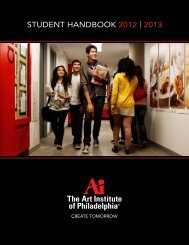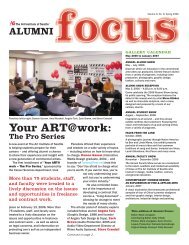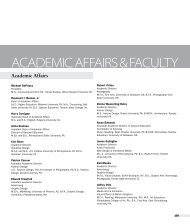2009 - 2010 Catalog - The Art Institutes
2009 - 2010 Catalog - The Art Institutes
2009 - 2010 Catalog - The Art Institutes
You also want an ePaper? Increase the reach of your titles
YUMPU automatically turns print PDFs into web optimized ePapers that Google loves.
advisor. Primary concentration tracks include<br />
10 courses, of which 5 are in the upper division.<br />
(Prerequisite: may vary based on specifi c courses)<br />
4 Credits<br />
SM1402 - Studio Major II:<br />
<strong>The</strong> student declares a primary studio concentration<br />
and track from a design discipline<br />
offered at the college in consultation with their<br />
advisor. Primary concentration tracks include<br />
10 courses, of which 5 are in the upper division.<br />
(Prerequisite: may vary based on specifi c courses)<br />
4 Credits<br />
SM2403 - Studio Major III:<br />
Th student declares a primary studio concentration<br />
and track from a design discipline<br />
offered at the college in consultation with their<br />
advisor. Primary concentration tracks include<br />
10 courses, of which 5 are in the upper division.<br />
(Prerequisite: may vary based on specifi c courses)<br />
4 Credits<br />
SM2404 - Studio Major IV:<br />
<strong>The</strong> student declares a primary studio concentration<br />
and track from a design discipline<br />
offered at the college in consultation with their<br />
advisor. Primary concentration tracks include<br />
10 courses, of which 5 are in the upper division.<br />
(Prerequisite: may vary based on specifi c courses)<br />
4 Credits<br />
SM3405 - Studio Major V:<br />
<strong>The</strong> student declares a primary studio concentration<br />
and track from a design discipline<br />
offered at the college in consultation with their<br />
advisor. Primary concentration tracks include<br />
10 courses, of which 5 are in the upper division.<br />
(Prerequisite: may vary based on specifi c courses)<br />
4 Credits<br />
SM3406 - Studio Major VI:<br />
<strong>The</strong> student declares a primary studio concentration<br />
and track from a design discipline<br />
offered at the college in consultation with their<br />
advisor. Primary concentration tracks include<br />
10 courses, of which 5 are in the upper division.<br />
(Prerequisite: may vary based on specifi c courses)<br />
4 Credits<br />
SM4407 - Studio Major VII:<br />
<strong>The</strong> student declares a primary studio concentration<br />
and track from a design discipline offered<br />
at the college in consultation with their advisor.<br />
Primary concentration tracks include 10 courses,<br />
of which 5 are in the upper division.(Prerequisite:<br />
may vary based on specifi c courses) 4 Credits<br />
SM4408 - Studio Major VIII:<br />
<strong>The</strong> student declares a primary studio concentration<br />
and track from a design discipline<br />
offered at the college in consultation with their<br />
advisor. Primary concentration tracks include<br />
10 courses, of which 5 are in the upper division.<br />
(Prerequisite: may vary based on specifi c courses)<br />
4 Credits<br />
TRANSITIONAL<br />
STUDIES COURSES<br />
TS094 - Transitional Studies: English:<br />
This course emphasizes the skills needed to produce<br />
clear, competent English prose. Coursework<br />
concentrates on basic paragraph writing with<br />
its attendant skills: various sentence structure,<br />
spelling, subject/verb agreement, punctuation,<br />
and correct verb tense. (Course is required for<br />
students with an Accuplacer Sentence Skills<br />
placement score of less than 87) Students will require<br />
a “C” or higher to pass Transitional English.<br />
(Prerequisite: none) 4 Credits<br />
TS095 - Transitional Studies: Mathematics:<br />
This course reviews the mathematics that is the<br />
foundation for the requirements of a degree<br />
program. <strong>The</strong> course focuses on conceptual<br />
understanding of problem solving, decision<br />
making, and analytical skills dealing with quantities,<br />
their magnitudes and inter-relationships.<br />
<strong>The</strong> course includes: complex manipulation of<br />
whole numbers, fractions, decimal numbers;<br />
ratios, proportions, and percentages; geometry<br />
(emphasizing the calculation of area and volume<br />
of complex 2D and 3D objects); algebra (emphasizing<br />
the manipulation of negative and positive<br />
numbers and the solution of linear equations;<br />
beginning statistics (graphing, mode, mean and<br />
median). (Course is required for students with<br />
an Accuplacer Elementary Algebra placement<br />
score of less than 57). Students will require a<br />
“C” or higher to pass Transitional Mathematics.<br />
(Prerequisite: none) 4 Credits<br />
VISUAL EFFECTS &<br />
MOTION GRAPHICS<br />
COURSES<br />
VE1409 - History And Trends Of<br />
Visual Effects:<br />
This course provides an overview of the visual<br />
effects industry, with an emphasis on traditional<br />
techniques and their historical context. This survey<br />
class also explores major trends in the visual<br />
effects industry, and identifi es career opportunities<br />
in the fi eld. (Prerequisite: none) 4 Credits<br />
VE1438 - Computer Graphics:<br />
This course will explore the history, psychology,<br />
and artistic interpretation of typography<br />
and digital design elements. Focus will be upon<br />
systematic application of typographic elements<br />
to enhance readability and visibility as well as<br />
communications for video, digital publishing,<br />
computer animation, and broadcast graphics.<br />
Desktop publishing activities will include the integration<br />
of computers and vector-based drawing<br />
programs. (Prerequisite: GD1403 - Typography<br />
for Digital Media) **This course requires a “C” or<br />
higher to pass. 4 Credits<br />
VE1457 - Conceptual Storytelling:<br />
<strong>The</strong> course is an introduction to storytelling<br />
and the components of story. <strong>The</strong> goal is to<br />
develop storytelling skills, and an understanding<br />
of story form. Students will examine story art<br />
through story structure, character and composition.<br />
Students will be presented with the tools,<br />
techniques, and understandings of what stories<br />
are and how they work. <strong>The</strong> course will comprise<br />
reading, writing, and discussion about traditional<br />
storytelling as well as the impact of technology<br />
and interactivity on storytelling. Students will<br />
learn to craft, analyze and critique stories while<br />
working with the tools necessary to present<br />
material in digital format. (Prerequisite: none)<br />
4 Credits<br />
VE2450 - Maps, Mattes, and Masks:<br />
This course continues the development of digital<br />
imaging skills, with an emphasis on advanced<br />
techniques in masking, maps, channels, and compositing.<br />
(Prerequisite: CA2429 - Introduction to<br />
3D Modeling) 4 Credits<br />
VE2453 - Introduction to VFX:<br />
This course will explore basic color theory and<br />
the various techniques of digital compositing.<br />
Emphasis will be placed on combining separately<br />
shot pieces of live action footage to create a<br />
seamless fi nished shot. (Prerequisite: CA2430 -<br />
Introduction to Video) **This course requires a<br />
“C” or higher to pass. 4 Credits<br />
VE2467 - Production Design:<br />
This course explores the production designer’s<br />
role of interpreting a screenplay (or similar<br />
work), and then combining reality and imagination<br />
to create visual elements that reinforce the<br />
screenplay’s narrative and aesthetic requirements.<br />
Students will consider both the explicit<br />
and underlying meanings in a scene, and then<br />
employ set and effects design to reinforce these<br />
ideas. (Prerequisite: VE1457 - Conceptual<br />
Storytelling) 4 Credits<br />
VE2481 - Interactive Visual Design:<br />
Students learn about interactive computer programs<br />
that combine animation with facilities for<br />
integrating text, sound, images, and fi ll-motion<br />
video into interactive products. This course<br />
allows students to explore the role of 2D and<br />
3D animation in the production of interactive<br />
69



